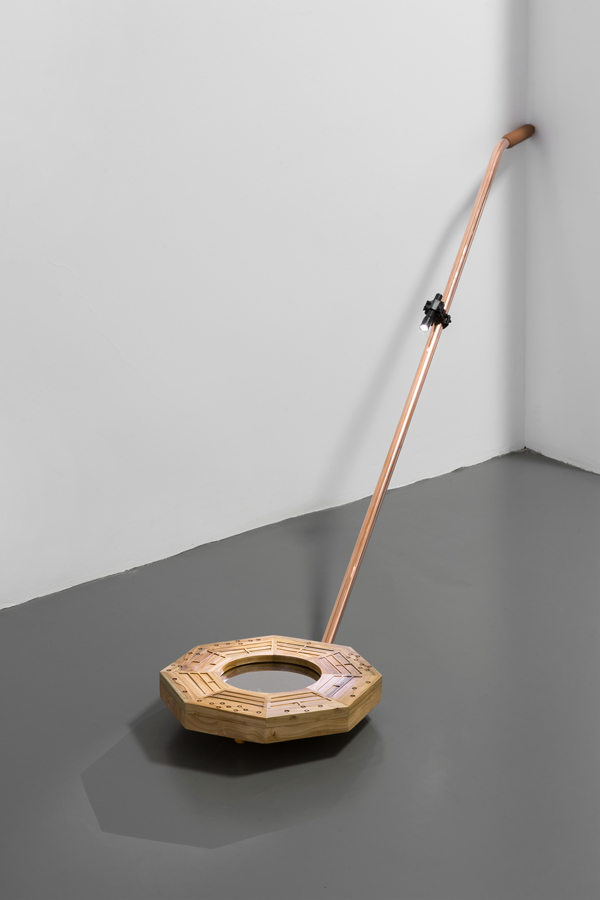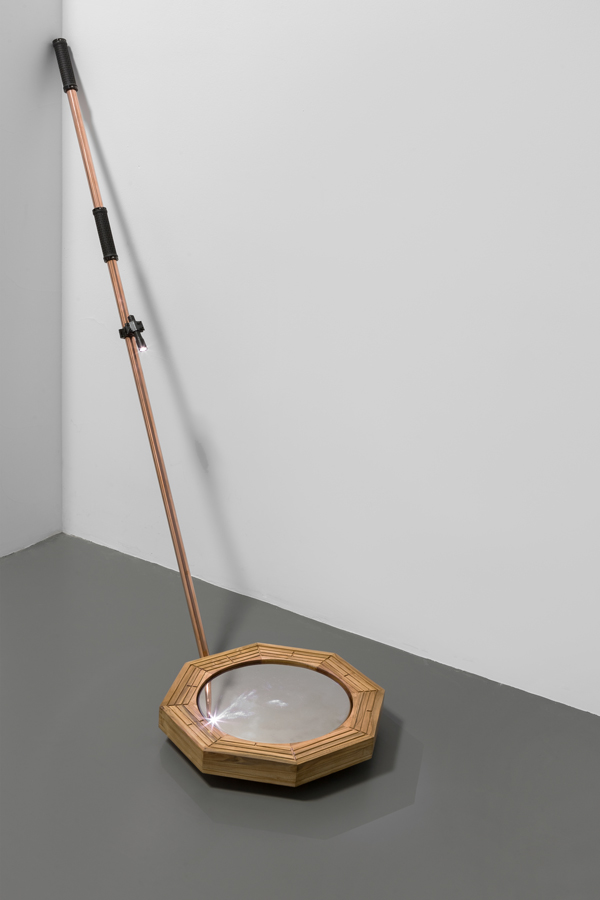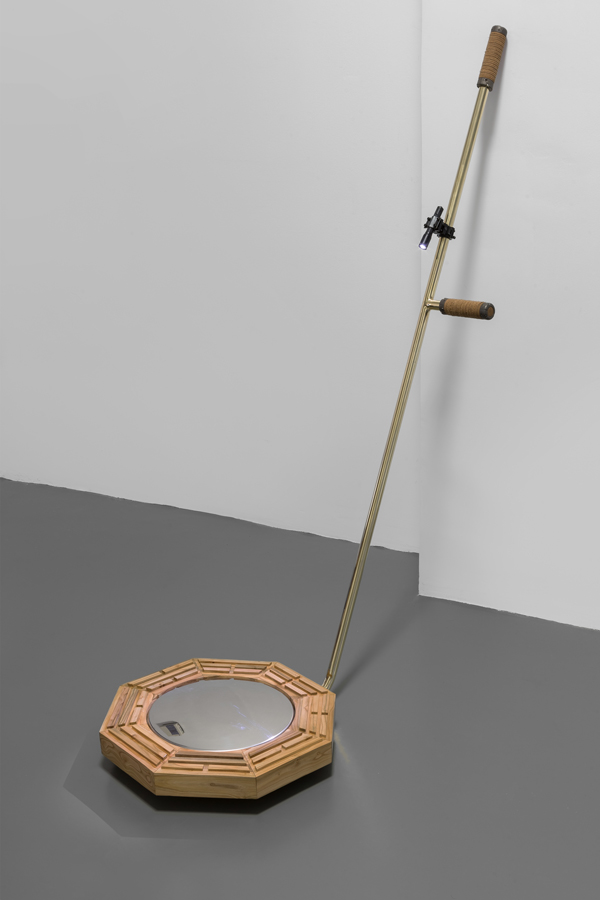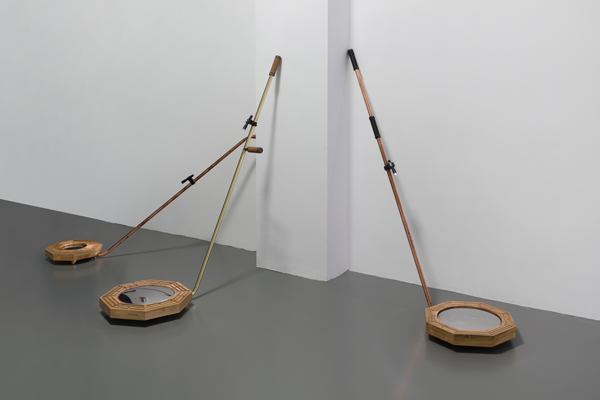桃木板、虫胶、不锈钢镜、铜管、脚轮、把套、镀锌螺丝、不锈钢螺母、手电筒、手电支架 / peach wood boards, shellac, stainless steel mirrors, copper tubes, casters, hand grips, galvanized screws, stainless steel nuts, flashlights, flashlight mounts,86×38×38 cm, 140×44×44 cm, 136×49×49 cm , 2019
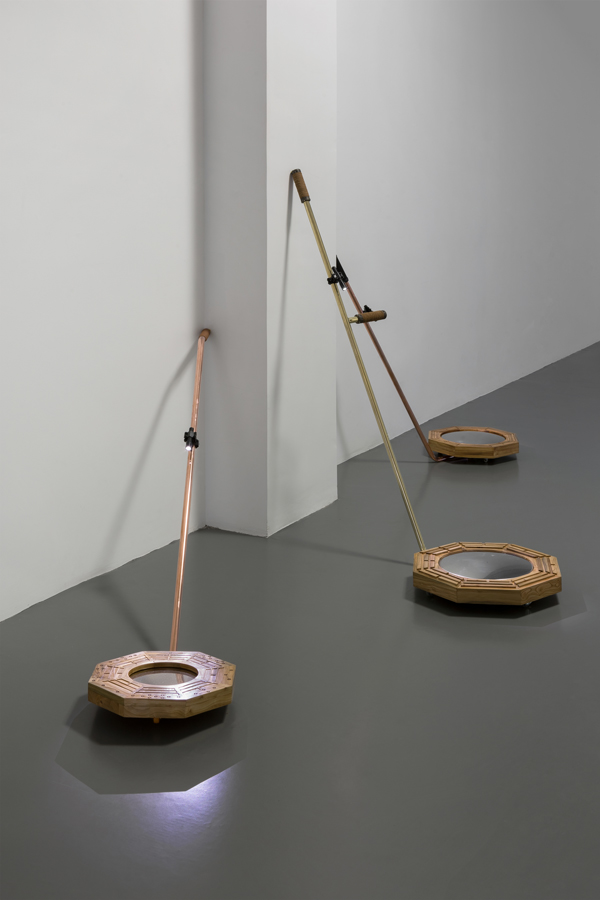
作品自述 / Artist text:
近些年来,我越发能够留意到职业安保群体、安保系统的在场性与不可见的公共安全管理逻辑有着同步的戏剧性扩张。一个与以上两者都高度相关的背景应该包括中国城市的剧烈转型:即便在经济理性上需要鼓励人口流动,在社会心理上也会强化对流动人口的不安全感并反映在政策和社会现场之中。因而最容易见证密集安保系统和人员配置的地方通常也是流通量最高的交通枢纽,如国内一二线城市的机场、高铁站、地铁站以及高速检查站等。
这种两重性体验也帮我桥接起记忆中两段本不会相交的个人经历:在东南亚的国家乘车进入公共场所前,需配合安保人员排查汽车底盘上是否安装了可疑装置;在珠三角的老城区常有机会留意到民宅门前各式各样的八卦镜。人们似乎共享一种跨越地域和文化的历史经验,即敌对行为总是在看不见的地方伺机而动,因此有必要展现某些有着震慑意味的仪式,并期望外来的窥探在一种秩序操演面前能够知难而退。
这类操演或能追溯至许多文明的诞生之初,且一路延展至今日的网络空间中的公共表达。这种经久不衰的仪式启发我尝试将其中的两种关键道具:安检镜和八卦镜,在保留各自范式的前提下融合出一种法器:既给安检镜加持了驱逐鬼魅的神力,也让八卦镜增加了意外的机动性和应用场景。
在为这件作品命名时,我参考了汽车品牌对车款人格化的命名方式。制作并展示这些浮夸的安检器物,并非为了庆贺对流动中的人、物甚或无形的信息、数据的查验。或许它们的存在能够显像一种越来越有正当性的旧心智乃至旧营生。
—
In recent years, I’ve become increasingly aware of a performative expansion of the presence of security professionals and systems, and concurrently, of the invisibility of the logic of public security administration on the other. The backdrop highly relevant to both is the drastic urban transformation of Chinese cities: although mobility is favoured by the reasoning of economics, the transformation has also strengthened feelings of insecurity towards floating populations. Hence, places that are most intensely surveilled are often transport hubs with the highest traffic, including airports, high-speed railway stations, subway stations and highway checkpoints of the first and second-tier cities.
This layered experience bridged two other supposedly unrelated experiences for me: in Southeast Asian countries, security personnel inspect the undercarriage of vehicles before entering public places; in the Pearl River Delta of the Guangdong Province, walking through the historic districts, one notices all kinds of Bagua mirrors at the front door of residential buildings. In both scenarios, a shared historical experience seems to have crossed geographical and cultural differences: since antagonism always lurks around, displays of deterrence are necessary. It is expected that unwanted pryers will be intimidated by the performance of order.
These performances may find their roots in numerous public expressions, stretching back to the dawn of civilisations and persisting on the internet today. The enduring nature of these rituals inspired me to invent a new ritualistic device out of the two key objects—the inspection mirror and the Bagua mirror—while retaining their respective paradigms. The resultant device is a spiritually enhanced inspection mirror, capable of expelling demons, and at the same time a surprisingly versatile Bagua mirror.
When naming this work, I referenced naming practices of automobile brands, who often personify their models. These extravagant security inspection devices are not a celebration of the surveillance of displaced individuals, objects, and intangible information and data. Instead, they serve to illustrate a progressively legitimised mindset and even a livelihood, both rooted in a longstanding history.
*
展出履历 / Related Exhibitions:
智能秩序,69 Art Campus,北京,2023
漫游者之歌,空白空间,北京,2019
Smart Order, 69 Art Campus, Beijing, 2023
A White Space Odyssey, White Space Beijing, Beijing, 2019
